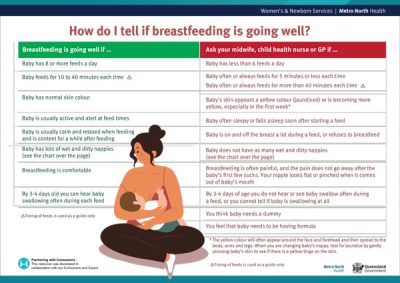Beginning to breastfeed
Congratulations on baby’s arrival!
We notice that you have said you would like to breastfeed your baby. The coming days will be busy for you, so we wanted to provide you with some short “snapshots” of information about feeding your baby.
When baby is telling you “I’m getting hungry”
You may recall that it is best to respond to baby’s early feeding cues – don’t wait for baby to be crying. Here is a poster to help you figure out what the early feeding cues are.
Latching baby comfortably at the breast
This 15-minute Breastfeeding Basics video from the Australian Breastfeeding Association is a great introduction to breastfeeding. It includes information on getting started with breastfeeding, how to latch the baby at your breast and how to know baby is getting enough milk.
Here are some links to other videos with tips on how to latch baby at the breast:
Baby-led latch from https://raisingchildren.net.au/newborns
Getting a good attachment from https://raisingchildren.net.au/newborns
It is a great idea to watch these videos a few times to learn some of the skills to latch baby. After viewing them you may want to discuss any questions with your midwife/nurse.
More breastfeeding videos can be found at Raising Children Network, including one showing Breastfeeding positions.
How will I know if feeding is going well?
 Babies usually breastfeed 8 or more times in a day, including through the night.
Babies usually breastfeed 8 or more times in a day, including through the night.
If you want a reminder on how to know if breastfeeding is going well, have a look at this poster and have a look at this poster and watch the section “How do I know if baby is getting enough?” in the Australian Breastfeeding Association’s “Breastfeeding Basics” video again.
You will also have a copy of the Australian Breastfeeding Association’s poster called “Normal Nappies: What to expect” in your discharge pack – this has some great photo cues and some tips about breastfeeding in the early weeks.
Learn how to hand express!
If breastfeeding is going well, feeding your baby at the breast is often easiest. If you need to express extra breastmilk for your baby, hand expressing is a helpful skill to know. Hand expressing is quick, you don’t need special equipment, and it can help your breasts to make more milk.
As a reminder…
Tips to latch baby at the breast:
- Respond to baby’s early feeding cues
- Place the baby skin-to-skin and allow them to self-latch
- In the early days a semi-reclined position allows gravity to hold baby in position, while you work out where to place your hands
- Allow the baby time to “mouth” and search for the breast
- Shape the breast if needed but make sure your fingers are well away from the nipple
- Adjust the baby’s body so they face you fully, their chest and tummy have contact with your body, and the cheeks, chin and lips have contact with the breast
- Adjust baby’s position and not the position of the breast
- The nipple will be at the level of the baby’s nose just prior to latching
- Hold baby in close to you – remove wraps or clothing so that they are close to your body
- Keep baby’s bottom tucked in close to your body as this will help the nose sit a little away from the breast
- Make sure that baby is well supported and that their head and body are in a straight line (aligned) and their body is not twisted
- Do not hold baby behind the head to assist with the latch as they may pull away from the breast and not get a deep latch
If you are worried about how baby is feeding…
If you are worried at all about how baby is feeding once you get home, talk with your midwife/nurse or doctor to get advice.
You may also like to call 13 HEALTH (13 43 25 84) to talk with a Child Health Nurse, or 1800 mum 2 mum (1800 686 268) to talk with an Australian Breastfeeding Association breastfeeding counsellor.
For More Information
Queensland Health booklet “Child Health Information Your guide to the first 12 months” (The Red Book)
Queensland Health Breastfeeding website
Australian Breastfeeding Association website and Helpline: 1800 mum 2 mum 1800 686 268
Contact us
Lactation Service
Phone: (07) 3646 2250
